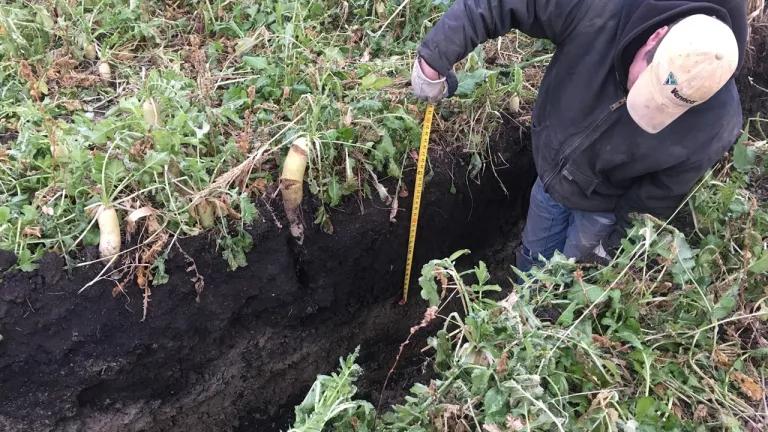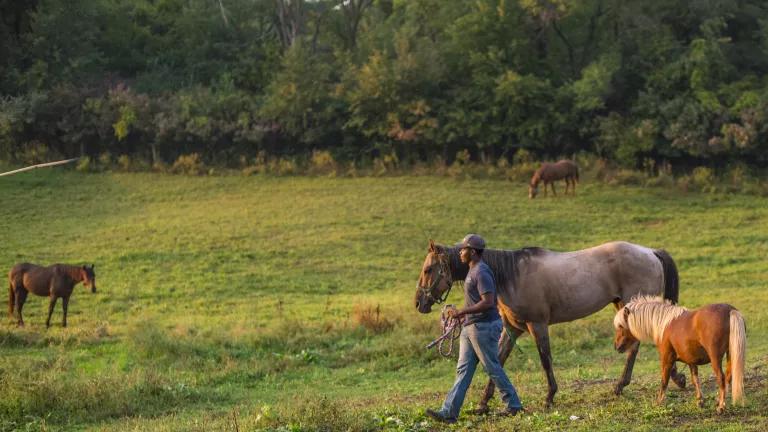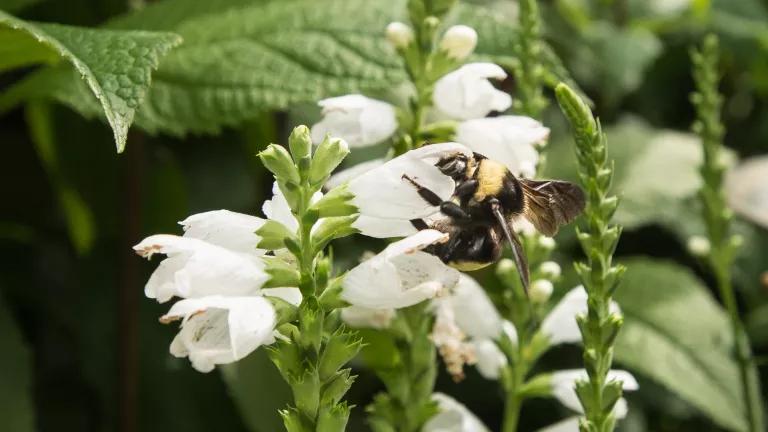Guest Blog: Reducing Nutrient Loss on Small No-Till Farm

My team and I had the pleasure of learning about soil health from small farmer, Rebecca Roberts, who became a farmer to serve as an example of a small, no-till, hand-tended farm that's working to build healthy soil and reduce her impact on the kinds of nutrient runoff that contributes to HABs. In this blog Rebecca shares her experience, lessons learned on her journey, advice for other farmers, and policy ideas that can help other farmers make more informed nutrient management decisions.
Modern no-till practices on hand-tended farms: do we still cause HABs?
Small farms need more research on how modern no-till practices affect nutrient loss
By Rebecca Roberts, M.S., owner/operator of Endless Farm
I began farming to fix nutrient pollution, and I continue to farm because, for healthy people and planet, we need to grow more vegetables in a way that reduces farms’ impact on the environment.
We don’t currently produce enough fruits and vegetables in the U.S., or in the world, to provide a healthy diet. Nearly 31% of vegetables and 50% of fruit in the U.S. are imported, and we need to triple fruit and vegetable production to meet the world’s nutritional needs. We have a responsibility to ensure vegetables are available to everyone at a price that is fair to consumers and profitable for farmers, without increasing nutrient pollution.
I don’t begrudge any farmer for choosing to manage their soil the way they do - growing food profitably is challenging, and every farm has different limitations. But some practices, like cover cropping and no-till farming, practices that I’m figuring out on my own farm in Rhode Island, can significantly reduce nutrient loss.
No-till farming is simply farming without plowing or tilling the soil. Undisturbed soil forms clods and natural channels for water and air movement, improving soil structure and increasing soil organic matter. But these practices alone do not guarantee that nutrients won’t leave the field. Even in Rhode Island, where 96% of farms are less than 180 acres and 36% of farms are under 10 acres, and nearly 15% of farms are no-till or low-till (USDA NASS, 2017 Census of Agriculture), in the last three years, the NRDC’s harmful algal bloom mapping project counted at least 18 harmful algal blooms (HABs) in Rhode Island. Farms of all sizes, practices, and products can make a difference in reducing nutrient pollution that causes these blooms.
Looking for solutions to agricultural nutrient pollution
I was introduced to the deadly consequences of HABs while I worked in Dr. Bart DeStasio’s lab at Lawrence University. We were monitoring microcystin, a toxin produced by some harmful algal blooms (HABs) that has led to fishkill and cases of wildlife, pet, and infant illness. I knew that nutrient runoff from agricultural fields, especially concentrated animal feeding operations (CAFOs) was a major cause of the nutrient-rich waters HABs need to survive, but I didn’t know how to come up with solutions for farms to reduce pollution from working on monitoring water quality.
After working on a few small vegetable farms after college, I learned that farmers can grow cover crops in the off-season to cover the soil year-round and reduce nutrient leaching. I joined Dr. Mike Castellano’s biogeochemical nutrient cycling laboratory at Iowa State University, and my research there explored reducing soil nitrate loss with a cover crop. We grew a cereal rye cover crop over the winter, and in the spring, we experimented with terminating the cover crop long before or soon before seeding soybeans. We found that leaving the rye growing in the field longer significantly increased both our cover crop growth and nutrient uptake, without slowing down soybean growth in the spring- right at the biggest time of year for nutrient loss from bare fields! I hear from fellow farmers that they’re often worried about cover crops reducing future crop yields, but our results did not find a negative effect.
And those were just the benefits of rye, a grass. The possibilities were even greater with a legume cover crop. Legumes form root associations with mycorrhizae, fungi that can take nitrogen out of the air and fix it into the soil. A well-timed legume cover crop can fix enough nitrogen to support a whole corn crop- up to 250 pounds/acre. You can grow your own fertilizer! This is great news for our pocketbooks and our soil health.
But cover crops are typically managed with tillage, or on large-scale no-till farms, with herbicides. Can smaller farms without tractors still manage cover crops without herbicides, too?
No-till farming
I founded Endless Farm, a certified organic, no-till vegetable farm in 2018 in Johnston, Rhode Island. My fields and a few neighboring farms are nestled in beautiful Snake Den State Park, on historic farmland that’s been in production since the early 1700s. Informed by my research on HABs and soil nutrient management with cover crops, I keep the idea of closing the nutrient loop close to my heart as I develop organic no-till practices on my farm.

I pursued no-till farming not only for its benefits to soil structure and potential to reduce environmental impact, but also because it requires significantly lower infrastructure investments, is a safer working environment, and is more suited to vegetable cropping. Many no-till and low-till farmers rely on hand tools alone or use more affordable walk-behind tractors.
No-till agriculture follows in the tradition of hoe agriculture, one of the oldest forms of agriculture. Hoe agriculture has traditionally been practiced on smaller, long-season, intensively managed fields, while plough agriculture favors large acres of short-season grain crops. In contrast to the upper body strength that favors male plough use, women traditionally participated more equally in hoe agriculture. Today we see that descendants of hoe-based societies hold more equal beliefs about gender roles and hoe-based societies have more equal representation in government and the labor market compared to plough-based societies.
Research on novel practices and hand tools-based practices
As we grow more fruits and vegetables to meet the nutritional needs of our populations, and as more farmers practice no-till farming on a small scale, we need to learn more about how no-till practices affect nutrient movement through the soil, water, and air, and what the potential is for reducing nutrient loss with no-till agriculture. While organically derived mulches like wood chips, compost, and cover crops have been used through the ages to manage weeds and soil nutrients, new practices are developing which employ plastic mulches to increase efficiency and mitigate the cost of sourcing local organic mulches. Thick black plastic tarps are used for occultation, landscape fabric with holes for plants suppress weeds in long-season crops, flame weeding and stale seed bedding preventatively reduce the weed seed bank, and flail mowing, rolling/crimping and sickle bar mowing manage cover crops.
We’re just starting to learn about how these practices affect nutrient movement in the soil. For example, tarps warm the soil, which increases microbial activity, making more nitrogen available. This can be good for new transplants, but can increase nitrogen leaching from soil, exacerbating HABs. We don’t yet know how impermeable tarps affect loss of other important nutrients, like phosphorus, nor how soil microbial populations change as the soil under the tarp dries, nor how clear, white, and black tarps differ in affecting nutrient availability.
Making informed decisions
Many research labs across the world have been working on methods to reduce nutrient loss from large-scale and tractor-based farms. But 90% of farmers are part of small family farms, and over a quarter of farmers have been farming less than 10 years. For small farmers to make informed decisions about keeping nutrients in the soil for crops, not for pollution, we need:
- Funding for research on how tractor-less no-till farming practices affect the soil ecosystem and nutrient movement
- Research on cover crop management on tractor-less farms, specifically on preventing regrowth that can cause cover crops to become weeds
- More education for farmers of all sizes about how they can reduce their contributions to HABs
- More access to regular soil testing and nutrient budgeting
- Consistent funding for organic cost share in Farm Bill. Organic farmers must use certified organic seed when available, which usually costs more. The Natural Resource Conservation Service provides impactful subsidies to reduce the cost of cover crops, and proportionally increases reimbursements for organic practices
- Infrastructure that connects raw material resources to farms. In the Northeast, I’ve partnered with arborists and landscapers who have woodchips, grass clippings, and leaves by the truckload. Local programs to divert these resources from landfills could help resource generators and farmers looking to add more organic mulches.
- More consumer awareness of the environmental benefits of no-till and other practices so they can support farmers that employ those practices through their purchasing decisions.
P.S. Looking to dip your toe into cover crops?
Check out easy-to-manage winter-kill cover crops like tillage radish. Tillage radish can be broadcast into a field or tossed into a garden plot in the fall. When the frost comes, the deep roots will die, but the leaves flatten down to cover the surface, protecting soil from the spring runoff that is a major source of phosphorus pollution. The roots decompose over the winter, and in the spring with a quick topdressing of compost, the field is full of organic matter and ready to plant!



